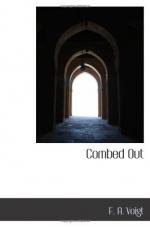Here, too, there were many dead. A little way off the road lay an Englishman who could not have fallen more than a few days before. His hands were clenched, his mouth wide open, his eyes fixed and staring. Near him was a tall German. He lay at full length with arms outstretched and legs crossed. His left hand, immersed in a pool, was white and puffy. His right hand was half closed and only slightly wrinkled. His side had been ripped open and fragments of entrail projected from the rent. The water beneath and around him was stained with blood. His pockets were turned inside out and papers and postcards lay scattered around in the usual manner. His cloak had been thrown across his face.
Other bodies had lain unburied for several months; others for several years, and of these only the mud-stained bones were left.
We reached the highest point in the series of so-called ridges. The desolate country spread out before us—miles and miles of low undulations ploughed by shell-fire and bared of everything except an occasional concrete shelter or the splintered stump of a dead tree.
We marched in silence through this dismal land of ruin and desolation. At length, in the distance, we saw a solitary fragment of a brick wall standing in a wide hollow, a sign that we were nearing a habitable region once again.
We passed by riddled German sign-boards—Vormarschstrasse, Hohenzollernstrasse, Kaiserstrasse, Mackensenstrasse, Admiral Scheerstrasse. We came to a litter of wreckage that had once been a village and then we left the main road and entered a little wood, or rather an assembly of scarred tree-trunks leaning at all angles. It was crossed by a zig-zag trench and all the refuse of battle lay scattered about.
An Australian soldier lay on a low mound. His head had dropped off and rolled backwards down the slope. The lower jaw had parted from the skull. His hands had been devoured by rats and two little heaps of clean bones were all that remained of them. The body was fully clothed and the legs encased in boots and puttees. One thigh-bone projected through a rent in the trousers and the rats had gnawed white grooves along it. A mouldy pocket-book lay by his side and several postcards and a soiled photograph of a woman and a child.
An attempt had been made to bury some of the dead, and several lay beneath heaps of loose earth with their boots projecting. But the rats had reached them all, and black, circular tunnels led down into the fetid depths of the rotting bodies. The stench that filled the air was so intolerable that we hastened to get out of this dreadful place.
Soon we perceived a church steeple far away. It brought some relief to the feeling of oppression and despair which had begun to burden us. We struck the road once again.
We passed houses of which the scarred walls were still standing, but with their bare, splintered rafters, empty windows, and riddled doors they looked more gloomy and forlorn than complete ruins. There were more concrete shelters and then some rusty iron cranes and the site of a “Munitionslager” from which every shell had been removed. We approached a small town. Many of the houses were intact except for scattered tiles and broken windows. The stately church was full of huge holes. All the streets were deserted.




